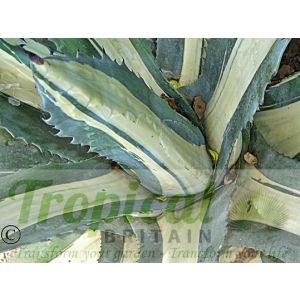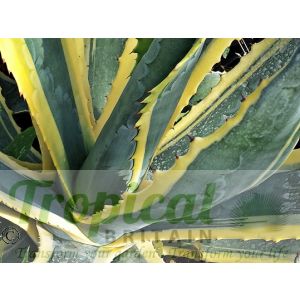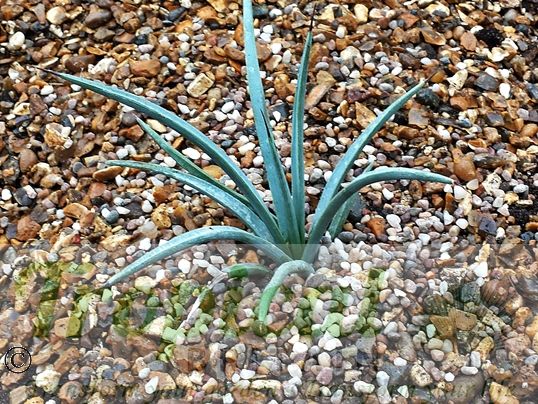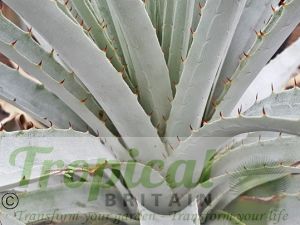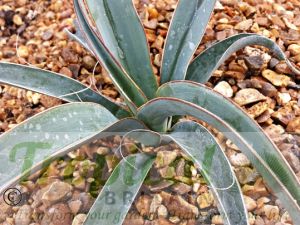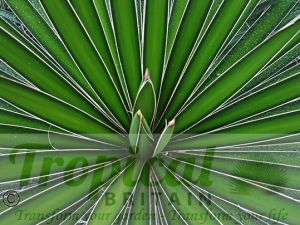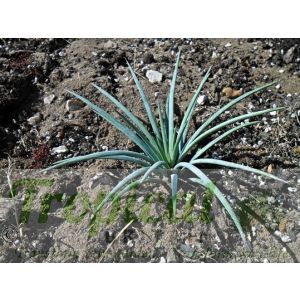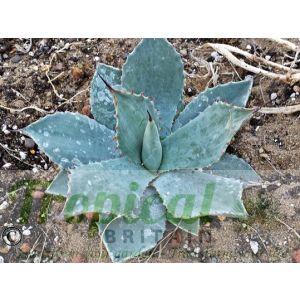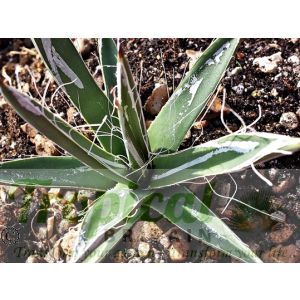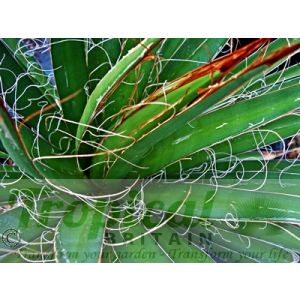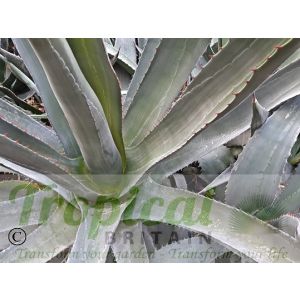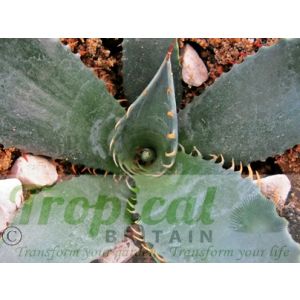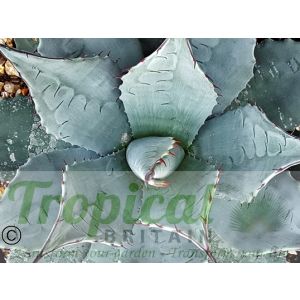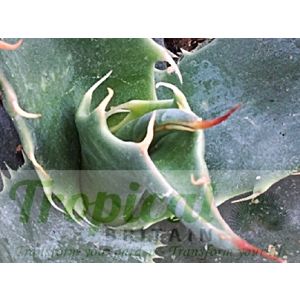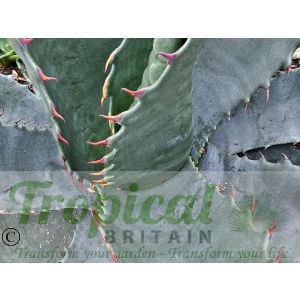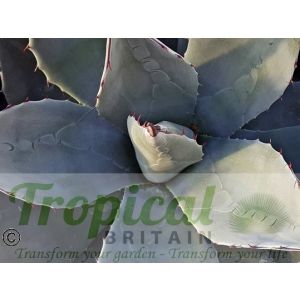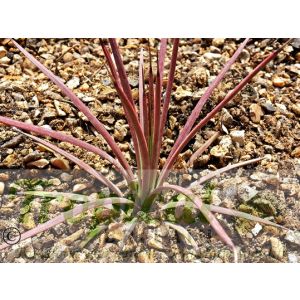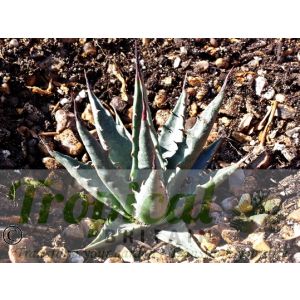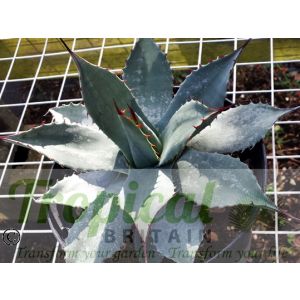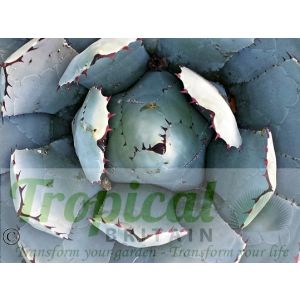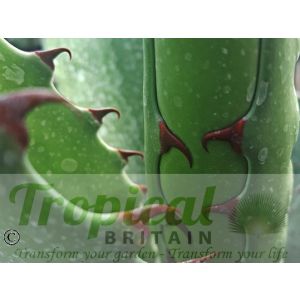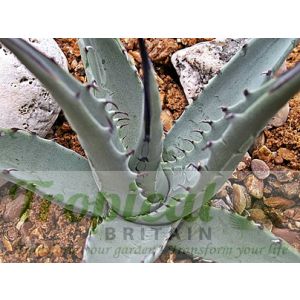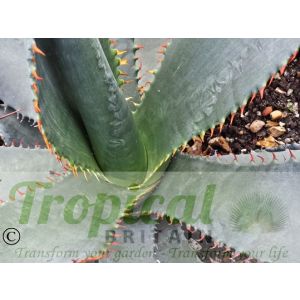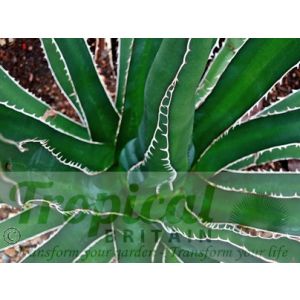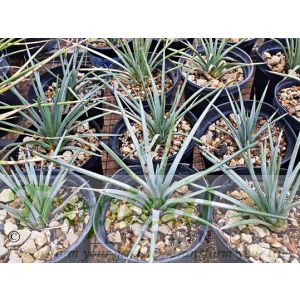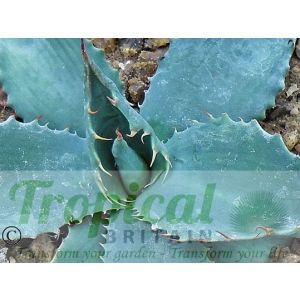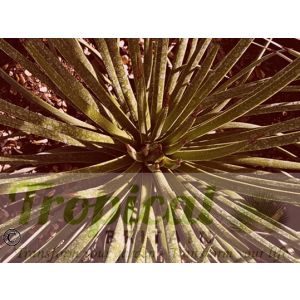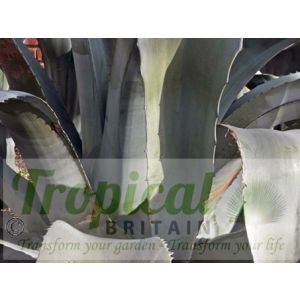Agave striata ssp falcata
- Buy 2 for £24.00 each and save 4%
- Striking architectural hedgehog-like form
- Glaucous sickle-shaped needle foliage
- Full sun
- Pefect drainage
Agave striata ssp. falcata is a highly ornamental Agave from Central and Northeastern Mexico to elevations of around 2100m. It produces numerous offsets and forms extensive colonizing populations. Its extremely beautiful - though very sharp - hedgehog-like foliage can be green but is more usually glaucous-green or sometimes reddish under climatic stress. There are various differences in the foliage between Agave striata ssp falcata and Agave striata ssp striata. In Agave striata ssp falcata the foliage is angled on the lower surface and smoothly rounded on the top surface whereas in ssp striata it is rounded on both surfaces forming a spherical cross-section. Falcate means sickle-shaped and ssp. falcata has a noticeable sickle-shaped hook to its outline in comparison to ssp. striata which tends to be more gently arching. Overall there are fewer leaves in ssp falcata, they are spread further apart and their density is less than that of ssp. striata. Howard Scott Gentry, when describing this subspecies, noticed this to be true of the clumping colonies as well as individual plants and that ssp. falcata developed shorter stems and smaller clumps built up by axillary branching. In appearance, the foliage is broader, stiffer, more heavy in Agave striata ssp falcata and this difference is quite apparent when the two subspecies are placed side by side. Variable in its range, Gentry also observed that the broader heavier foliage of the populations from Coahuila become narrower and less stiff further southwards, grading into the narrower striata leaf form in San Luis Potosi.
The lectotype for this subspecies was first collected by Friedrich Adolph Wislizenus at Buena Vista near Saltillo in Coahuila on the 23rd May 1847. During his expedition to Santa Fe in 1846, war had broken out between the United States and Mexico and slipping across the border into Chihuahua, Wislizenus was captured by the Mexicans. He was eventually rescued by Colonel Alexander Doniphan and during this time in Mexico in 1847 he collected several important specimens including three Agaves: Agave striata ssp. falcata, Agave parrasana and Agave asperrima ssp. asperrima.
Agave striata ssp. falcata should be grown more often in the UK. Given a free-draining substrate it is hardy to at least -8C in British conditions, possibly lower. Protecting it with fleece and a rain-shelter during the worst of the winter weather is sensible.
Highly recommended.
Additional Information
| Order | Asparagales |
|---|---|
| Family | Asparagaceae |
| Sub-Family | Agavoideae |
| Synonyms | Agave californica, Agave falcata, Agave falcata var. espadina, Agave falcata var. microcarpa, Agave paucifolia, Agave striata var. californica |
| Geographical Origin | Central and Northeastern Mexico: Coahuila, Durango, Nuevo León, Tamaulipas, San Luis Potosi and Zacatecas |
| Cultivation | Full sun. Perfect drainage. Gravelly, gritty, alkaline substrate with added limestone. A raised xeric bed and/or sloping gradient. Keep dry in winter and protect with fleece |
| Eventual Height | 90cm |
| Eventual Spread | 90cm |
| Hardiness | Surprisingly tough for an Agave that grows so far south in Mexico, it survives down to at least -8C and possibly more if kept completely dry with a raincover. Fleecing Agaves in the winter in most parts of the UK is sensible practice |
- Buy 2 for £24.00 each and save 4%

Free DELIVERY
ON ALL ORDERS OVER £99THIS OFFER IS VALID ON ALL OUR STORE ITEMS.
THE PLANTS
- Smaller-Growing Succulents
- Aeonium
- Agave
- Agave americana
- Agave amica
- Agave chrysantha
- Agave cupreata
- Agave deserti
- Agave filifera
- Agave gentryi
- Agave gomezpompae
- Agave havardiana
- Agave horrida ssp horrida
- Agave lechuguilla
- Agave mitis var mitis
- Agave montana
- Agave palmeri
- Agave parryi
- Agave polianthiflora
- Agave striata
- Agave stricta Rubra
- Agave toumeyana
- Agave univittata
- Agave utahensis
- Agave victoriae-reginae - Huasteca Canyon
- Aloe
- Beschorneria
- Bryophyllum
- Dasylirion
- Furcraea
- Hesperaloe
- Hesperoyucca
- Nolina
- Yucca
- Astrophytum
- Austrocylindropuntia
- Brasiliopuntia brasiliensis
- Cereus
- Chamaecereus silvestrii
- Cleistocactus
- Cumulopuntia
- Cylindropuntia
- Echinocereus
- Echinopsis
- Epiphyllum
- Ferocactus
- Gymnocalycium
- Hatiora
- Kroenleinia grusonii
- Lophocereus
- Maihuenia
- Mammillaria
- Matucana
- Myrtillocactus geometrizans
- Opuntia
- Opuntia arenaria SB964
- Opuntia atrispina
- Opuntia basilaris
- Opuntia chisosensis SB992 Brewster Co, TX
- Opuntia cymochila - Brewster Co, TX
- Opuntia engelmannii var. sandia
- Opuntia erinacea
- Opuntia fragilis
- Opuntia humifusa
- Opuntia lindheimeri - Beeville, TX
- Opuntia phaeacantha
- Opuntia pottsii var. nova DJF1441 SW Albuquerque, NM
- Opuntia robusta
- Opuntia sandiana
- Opuntia sanguinicola
- Opuntia stricta
- Opuntia strigil
- Opuntia trichophora
- Oroya peruviana
- Parodia
- Polaskia
- Rhipsalis
- Schlumbergera
- Stenocactus
- Stetsonia
- Tephrocactus
- Alocasia
- Amorphophallus
- Arisaema
- Arum
- Calla
- Caladium
- Colocasia
- Dracunculus
- Monstera
- Helicodiceros muscivorus
- Philodendron
- Pinellia
- Remusatia
- Sauromatum
- Spathantheum
- Typhonium
- Xanthosoma
- Zantedeschia
